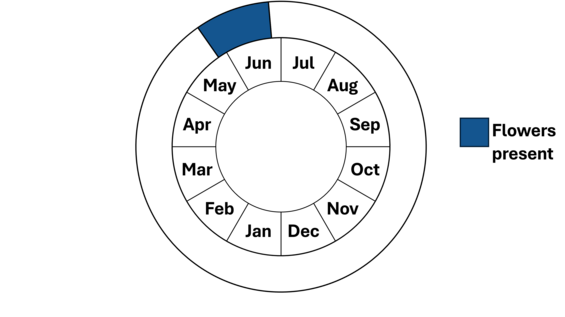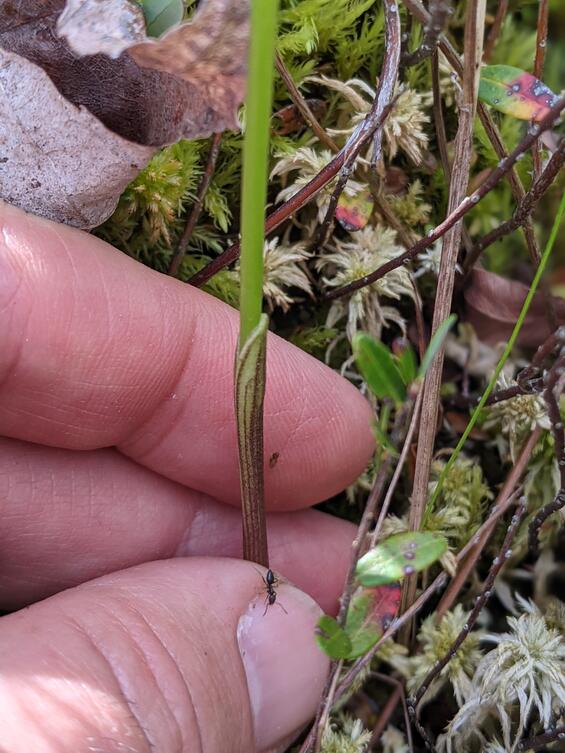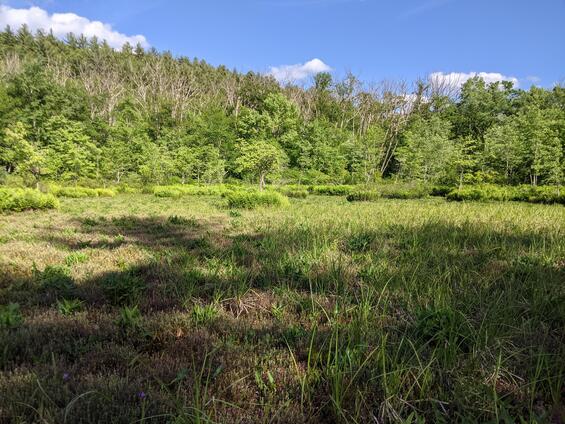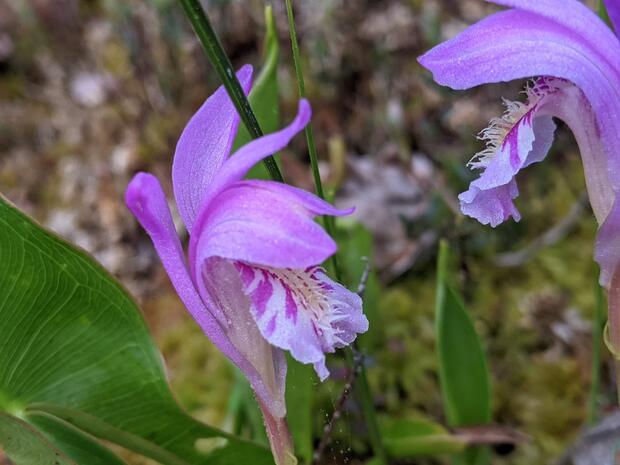- Scientific name: Arethusa bulbosa L.
- Species of Greatest Conservation Need (MA State Wildlife Action Plan)
- Threatened (MA Endangered Species Act)
Description
Arethusa or dragon’s-mouth (Arethusa bulbosa) is a showy perennial orchid usually 10 to 30 cm (4 to 11 in) tall. A single erect stem growing out of a bulbous corm (a thick, fleshy root stalk) is topped by one, or sometimes two, magenta to dark pink flowers. The labellum (lowest petal or lip) is about 2.5 cm (1 in) long and arches abruptly downwards. It has a whitish convoluted surface that is mottled with magenta and has a yellow center with yellow hairs. The other petals and the sepals are all colored pink and point upwards. The flower is pollinated by bumblebees of the genus Bombus.
Rose pogonia (Pogonia ophioglossoides) is similar in appearance but has a number of differences. The flowers of rose pogonia are shades of pink, rather than magenta. Two of its outer “petals” (actually pink-colored sepals) point sideways or downward rather than upward, and the labellum is deeply fringed along the margin. Additionally, rose pogonia has a leaf-like bract growing from the base of the flower which is not present in arethusa.
Life cycle and behavior

In Massachusetts, flowering occurs from late May to mid-June. After the flower has wilted, a single sharply pointed grass-like leaf grows from the uppermost scale on the stem, up to 20 cm (8 in) long and 1.2 cm (0.5 in) wide. Still later in the year, a fruiting capsule is sometimes seen on the dried flowering stalk. The capsule is elliptical, 2.5 cm (1 in) long, and has six pronounced ribs. The capsule will split late in the season, releasing dust sized seeds, which are scattered by the wind. A seed must land in an area appropriate for its growth (on Sphagnum moss or other similar surface) and contact the appropriate mycorrhizal fungi to germinate and develop a new corm. The pea-sized corm that produced the flower in May, will form a new corm 2 to 4 cm (0.75-1.5 in) from the old one, and the original one will disappear.
Population status

Photo credit: Robert Wernerehl
Arethusa is classified as a threatened species in Massachusetts. Populations of arethusa may vary greatly in number of plants from year to year.
Since 1999, this species has been recorded at 11 sites in Massachusetts. Of these, only three populations would be considered to have good populations in areas with sufficient habitat. Historically (prior to 1999), arethusa was known from an additional 43 locations, and an additional 58 records associated only with herbarium sheets that do not have specific locations, only mentioning towns as location. It is declining in apparently suitable habitat in inland bogs for reasons that are not known. The species does not appear to be declining as rapidly in coastal boggy areas.
Distribution and abundance
Arethusa is distributed from Newfoundland and Labrador west to southern Alberta and the Northwest Territories, south to North Carolina, Ohio, and Minnesota. It is of conservation concern across its range except in Minnesota and Wisconsin, Ontario, and eastern Canada. It is considered extirpated from Indiana and Maryland, and also may be extirpated from Connecticut, Delaware, Virginia and South Carolina.

Distribution in Massachusetts
1999-2024
Based on records in the Natural Heritage Database
Habitat
Arethusa is found in open peaty wetlands, bogs, boggy meadows, and inter-dune swales, usually with cranberry, sphagnum moss, sundews, rose pogonia, sedges, and shrubs such as sheep laurel and swamp azalea. Arethusa prefers open, early successional habitats but may persist in the shade of the shrubs.
Healthy habitats are vital for supporting native wildlife and plants. Explore habitats and learn about conservation and restoration in Massachusetts.

Photo credit: Robert Wernerehl
Threats
There are a number of known threats to this species existence. Destruction of wetland habitat by drainage and conversion for other uses has reduced available habitat. Further loss of habitat is occurring through ecological succession of bogs and meadows to red maple swamps and shrub swamps. Beaver flooding of habitats have also damaged or eliminated populations. Coastal storms and hurricanes frequently eliminate habitat in the interdunal swales but can create new habitat where dunes are undeveloped. Sea level rise may impact the populations that are currently doing well near the coast, some which are only 3-6 ft (10-20 ft) above sea level (Staudinger et al. 2024). Over-collection has also contributed to the scarcity of this native orchid.
In assessing the health of populations of arethusa, MassWildlife’s Natural Heritage Endangered Species Program (NHESP) looks not just at the number of plants in a population but also at how intact the habitat is, whether the hydrology is altered, how many openings are present which provide exposure to full sun, and if there is a large population of bumblebees and other flowers that will sustain the bee populations that pollinate arethusa when it isn’t in bloom. Another threat is the invasion of the habitat by exotic plant species. Late frosts after spring warming could destroy flowers and reduce the seed set in the population. Staudinger et al. (2024) predict an increase in extreme temperatures due to climate change. Another climate change result may be an increase in droughts. This species thrives in wetland areas, and prolonged droughts affecting its habitat will impact the populations in those areas.
Conservation
Survey and monitoring
Arethusa populations, like most orchids, can vary widely year to year depending on the exact conditions within their habitats. Regular monitoring provides information on the population over several years and can suggest specific actions that are necessary to sustain the populations. It is important to re-survey areas where populations occurred in the past but haven’t been seen in a few years.
The best time of year to survey for this species is when it is blooming. To determine the full extent of the population at a site, it should be visited several times during the flowering period. It is hard to detect when not in bloom.
Management
Management might include prescribed fire in areas which have become shaded by shrubs or red maples. This is proposed at one site. Management might also include removal of exotic species that may out-compete arethusa. Any management action needs to be done in consultation with NHESP prior to any actions.
Research needs
There is much that is not known about this charismatic orchid. Questions needing answers include: How long will the seed survive if it falls within a flooded habitat? What mycorrhizal fungi are associated with arethusa and how can these important support systems be protected and encouraged? Is arethusa sensitive to heat extremes and are the changing temperature regimes impacting it?
References
Go Orchids, North American Orchid Conservation Center, Smithsonian Environmental Research Center. 2025. https://goorchids.northamericanorchidcenter.org/species/arethusa/bulbosa/ Accessed 2/13/2025.
Haines, Arthur. Flora Novae Angliae. New England Wild Flower Society, Yale University Press, New Haven, CT. 2011.
NatureServe. 2025. NatureServe Network Biodiversity Location Data accessed through NatureServe Explorer [web application]. NatureServe, Arlington, Virginia. Available https://explorer.natureserve.org/. Accessed: 2/13/2025.
POWO (2025). "Plants of the World Online. Facilitated by the Royal Botanic Gardens, Kew. Published on the Internet; https://powo.science.kew.org/ Retrieved 13 February 2025."
Smith, Welby R. 2012. Native Orchids of Minnesota. University of Minnesota Press, Minneapolis MN.
Staudinger, M.D., A.V. Karmalkar, K. Terwilliger, K. Burgio, A. Lubeck, H. Higgins, T. Rice, T.L. Morelli, A. D'Amato. 2024. A regional synthesis of climate data to inform the 2025 State Wildlife Action Plans in the Northeast U.S. DOI Northeast Climate Adaptation Science Center Cooperator Report. 406 p. https://doi.org/10.21429/t352-9q86
Contact
| Date published: | March 20, 2025 |
|---|
